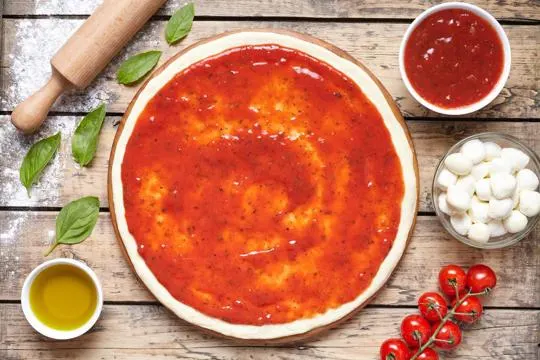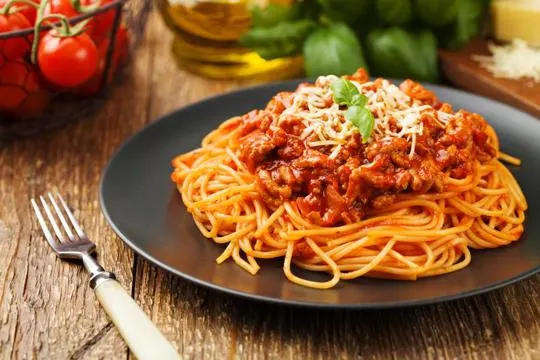Summary of key points
The primary variance between pizza sauce and spaghetti sauce is their texture and how they are prepared. Pizza sauce is typically uncooked, blended until smooth, and spread raw onto pizza dough before baking. It’s usually thicker with a more concentrated tomato flavor. Spaghetti sauce, or marinara, is cooked to develop a deeper, richer flavor, often includes more varied herbs and ingredients like garlic, onions, and sometimes meat, and has a thinner consistency suitable for coating pasta.
Ever stood in the kitchen, pizza dough ready, and wondered if you could just slap some spaghetti sauce on it? We’ve been there.
First off, yes, they’re both tomato-based champions in their own leagues. Yet, here’s the kicker: they’re crafted from the same core but dance to a different tune.
Pizza sauce, guys, it’s a raw deal. Not raw-tasting, but it’s typically uncooked. Straight from the can, onto the dough, bada bing, bada boom. It’s thick, it’s hearty, and it carries the crust like a pro.
Now, spaghetti sauce, that’s another story. It’s the simmer master, slow-cooked to perfection. It’s thinner, seasoned to impress, and filled with chunks of this and that. It whispers sweet nothings to your pasta.
Have we swapped them in a pinch? Absolutely. Did it work? Kinda. Did we learn something? Heck, yes.
The verdict? They each have their moments to shine.
What is Pizza Sauce?

Pizza sauce is an essential part of the classic Italian dish we know as pizza.
It’s a thick, creamy sauce made from ripe tomatoes, herbs and garlic.
This red sauce is smothered onto the pizza dough, forming a flavorful base for the toppings.
Pizza sauce has a unique consistency.
Unlike spaghetti sauce, it’s thicker and doesn’t make the dough soggy when baked.
This keeps the crust crispy. Plus, the thickness helps keep moisture away.
The flavor of pizza sauce is also distinct.
It’s robust, with a touch of sweetness and tanginess from the tomatoes.
Herbs like oregano and basil add a savory kick.
And pizza sauce serves another purpose.
Its thickness binds all the toppings together, so each bite has everything – cheese, meats, veggies.
In short, pizza sauce is essential.
Its texture, flavor and binding power make it the perfect partner for any delicious pizza.
What is Spaghetti Sauce?

Spaghetti sauce, also called marinara sauce, infuses Italian cuisine with flavor and versatility.
Prepared by simmering tomatoes with herbs, spices, and sometimes onions and garlic, this vivid sauce has a smooth texture and tangy taste that pairs well with pasta.
One of the primary features of spaghetti sauce is its capacity to boost pasta’s flavor.
Tomatoes, fresh or canned, form a deep base for the other ingredients.
Herbs such as basil, oregano, and thyme provide complexity.
Red pepper flakes or chili powder may be added for a mild kick.
Personal preference guides customization of the sauce.
Recipes may call for sautéing onions and garlic before adding tomatoes.
Or, pureed tomatoes may be used for a smoother texture.
To balance the acidity of the tomatoes, some cooks add wine or sugar.
Ingredients Used in Pizza Sauce and Spaghetti Sauce

Pizza sauce and spaghetti sauce have some common ingredients.
Tomato, herbs, and spices such as oregano, basil, garlic, and onion.
Pizza sauce is thicker and more intense than spaghetti sauce.
Pizza sauces are cooked and reduced for longer to create a richer taste.
Spaghetti sauce is simmered for a shorter time, so it coats the pasta evenly.
Also, some variations of spaghetti sauce include meat or mushrooms.
Tomatoes and Tomato Varieties
Tomatoes are a versatile fruit found in many cuisines.
Each type has its own flavor, color, and texture.
Knowing the various types is important for chefs and cooks.
Different tomatoes have different characteristics.
Some are sweet and juicy, others are more acidic and firm.
This variety provides culinary possibilities.
For example, Roma tomatoes are firm with low water content – perfect for sauces.
Beefsteak tomatoes are larger and milder, making them great for salads and sandwiches.
Cherry tomatoes offer sweetness and acidity – perfect for snacking or adding color to dishes.
Heirloom tomatoes come in many colors and sizes, often with special flavors.
San Marzano tomatoes from Italy have rich flavor and low acidity.
They are often used as the base for traditional Italian marinara sauces due to their natural sweetness.
Each tomato variety has its own characteristics.
Exploring these can help chefs create amazing dishes.
So, get creative with tomatoes. Your taste buds will thank you.
Herbs and Seasonings
Herbs and seasonings are a must for both pizza and spaghetti sauce.
They give flavor and make the dishes delicious.
Oregano, basil, thyme, and garlic are popular for pizza sauce.
Oregano is robust, basil adds sweetness, thyme is earthy, and garlic brings aroma.
For spaghetti sauce, oregano is often used with parsley, bay leaves, and marjoram.
Parsley adds brightness, bay leaves complexity, and marjoram floral notes.
Together with garlic, they create a rich sauce.
These herbs and seasonings give distinct flavors to the dishes.
Next time you enjoy your favorite pizza or pasta, appreciate the flavors from these humble ingredients.
What makes the sauces unique is not just the base, but the selection of herbs and seasonings.
So, try different combinations for your homemade pizza or spaghetti sauce.
Texture and Consistency
Texture and consistency set pizza and spaghetti sauces apart.
Pizza sauce is thicker and chunkier, while spaghetti sauce is smoother and has a more liquid-like texture.
This helps keep pizza sauce from making the dough soggy, and enables spaghetti sauce to coat the pasta evenly.
Pizza sauces also often contain small pieces of tomatoes or herbs, whereas spaghetti sauces usually have a finer blend of ingredients.
All these features make sure each sauce complements its dish perfectly.
Flavor Profile and Seasoning Differences
Pizza sauce and spaghetti sauce have different flavour profiles.
Pizza sauce is usually tangy and robust, while spaghetti sauce is milder and sweeter.
This is achieved through various herbs and spices.
For pizza sauce, oregano, basil, garlic and red pepper flakes are important.
These give it its sharpness and spice.
For spaghetti sauce, herbs like parsley, thyme and bay leaves provide a milder taste.
Plus, onion, carrot and celery add sweetness.
The difference lies in the seasoning.
Both sauces use salt and pepper for basic seasoning.
But, pizza sauce has bold herbs that work together for a strong taste.
Spaghetti sauce has more subtle herbs that create a delicate flavour.
Cooking Applications: How Pizza Sauce and Spaghetti Sauce Are Used

Pizza sauce and spaghetti sauce have different purposes.
Pizza sauce is mainly for pizza, and spaghetti sauce is for pasta dishes like spaghetti and lasagna.
Both can also be used for other Italian recipes.
Pizza sauce has a thicker texture and stronger taste, so it can hold up to oven heat without getting watery.
Spaghetti sauce is thinner with a milder taste, so it goes well with pasta and other ingredients.
Remember, these sauces can’t be swapped.
They have their own roles in what you’re cooking.
Nutritional Differences
Pizza and spaghetti sauce – they look the same, but nutrition-wise they differ.
Pizza sauce has more sugar and less salt. It’s sweeter, adding flavour.
Meanwhile, spaghetti sauce has a greater sodium content, to bring out the savoury taste.
When cooking, pay attention to these contrasts for desired recipes and diets.
What To Mix With Pizza Sauce and Spaghetti Sauce
Pizza sauce and spaghetti sauce can both be used for many dishes.
Mixing them with other ingredients leads to endless possibilities.
Veggies like onions, bell peppers, mushrooms, or spinach can be added to the sauce to make a nutritious meal.
Meat like ground beef or Italian sausage can be combined with the sauce, too.
Or try seafood like shrimp or clams for a unique twist.
Garlic, oregano, basil, and red pepper flakes are great condiments to enhance the sauces.
Get creative and explore different flavors.
The sauces can even be used as a base for other dishes.
Mix with cheese and cream to create a creamy tomato soup or use as a dip for breadsticks or mozzarella sticks.
So many options.
Conclusion
After conducting an extensive exploration on the differences between pizza and spaghetti sauces, it is clear that there are numerous distinguishing factors between the two.
Pizza sauce is usually thicker, spicier and contains a blend of diverse ingredients, while spaghetti sauce is thinner and more concentrated with tomatoes.
Although each has its own unique flavors and characteristics, both are mouthwatering staples to create delicious meals.
As detailed in this blog post, when creating either type of recipe there are many things to consider from the type of sauce used, to the ingredients added, to mix together a tantalizingly satisfying meal.
There’s no better way to tantalize your tastebuds than combining these delectable sauces with other fresh ingredients for a truly unforgettable meal experience.

Leave a comment